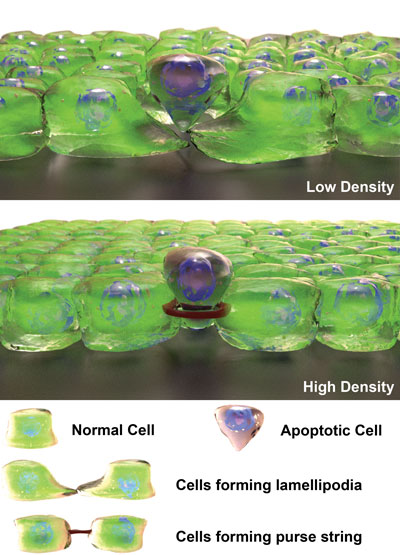Epithelial cell sheets act as a covering for most of the internal and external surfaces of the body. The classic example of an epithelial cell sheet is skin, but epithelial layers also line internal cavities such as blood vessels, stomach, and mouth. The primary role of the epithelium is a protective barrier against physical damage and infection attack. In order to perform this function, the integrity of the epithelial cell sheet must be maintained by balancing cell renewal and removal. Deteriorating, damaged, or unnecessary cells are targeted for elimination by apoptosis – the process of programmed cell death – allowing them to be eliminated without causing damage to the neighboring healthy cells, such as inflammation.

Figure: Cell extrusion mechanisms at different cell densities. At low density, apoptotic cells are extruded by cell crawling and lamellipodia, while purse-string contraction drives extrusion at high density. (Image credit: Dr Diego Pitta de Araujo, Mechanobiology Institute, Singapore).
Removal of these apoptotic cells from the epithelial cell sheet to maintain an intact barrier layer takes place by the process of cell extrusion, e.g. the intestinal villi epithelium renews completely every 5 days. To date, studies have shown that epithelial cell extrusion occurs via formation of a contractile ring of actin filaments and myosin motor proteins in the cells surrounding the cell targeted for extrusion. The contractile ring tightens around the base of the extruding cell, pushing it out of the epithelial sheet and bringing the surrounding cells together. Although this ‘purse-string’ mechanism of contraction is well established, previous studies have overlooked the full complexity of epithelial cell sheets. In particular, the epithelia is not just a collection of individual cells, but rather a multi-cellular layer that exhibits an inhomogeneity in cell dynamics and in cell density.
In order to account for this level of complexity, we created defined micro-patterns using microfabrication to control the growth and density of epithelial cell sheets. By observing cell extrusion events on these epithelial sheets with time-lapse and traction-force microscopy, we discovered that cell density and hence, cell-cell interactions led to two distinct modes of cell extrusion. At a low cell density, the cells in a tissue are quite dynamic and occasionally cell density becomes high in a small patch of the tissue. Cells in this region undergo apoptosis, and the cells surrounding the apoptotic cell selected for extrusion collectively crawl towards the targeted cell, and extend sheet-like protrusions called lamellipodia. The lamellipodia crawl underneath the apoptotic cell as they reach towards each other, and this action levers the apoptotic cell out of the sheet, causing its extrusion. However, at high density, collective cell movements are reduced preventing lamellipodia-based extrusion. Under these conditions, the cells surrounding the apoptotic cell form an actomyosin cable, and use purse-string contraction to squeeze out and extrude the cell.
Our study reveals that two distinct mechanisms exist to expel apoptotic cells from epithelial cell sheets. Selection between cell extrusion mechanisms is defined by cell density – cell crawling and lamellipodia extension is the predominant mechanism at low density, but purse-string contraction is favored at high density. The existence of these complementary mechanisms could be important for ensuring the removal of unnecessary cells (e.g., apoptotic cells) in different circumstances to maintain the integrity of the epithelial cell sheet.
Reference
Epithelial cell packing induces distinct modes of cell extrusions. Leyla Kocgozlu, Thuan Beng Saw, Anh Phuong Le, Ivan Yow, Murat Shagirov, Eunice Wong, René-Marc Mège, Chwee Teck Lim, Yusuke Toyama, Benoit Ladoux. Current Biology 2016 Nov 7;26(21):2942-2950. doi: 10.1016/j.cub.2016.08.057.
Mechanobiology Institute Singapore


































